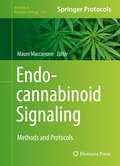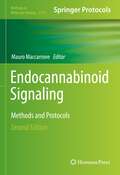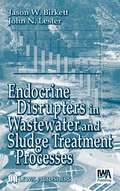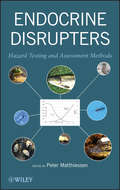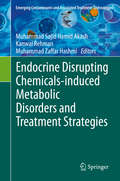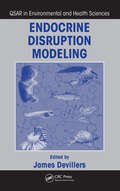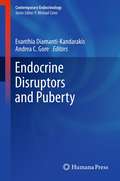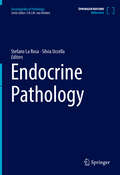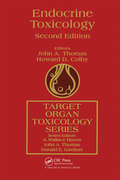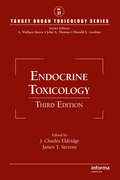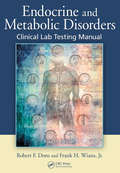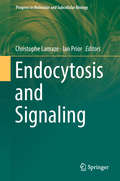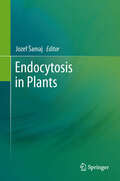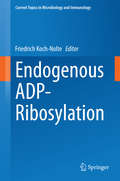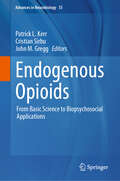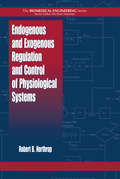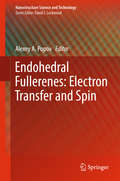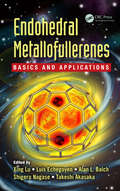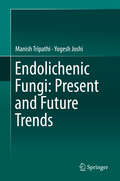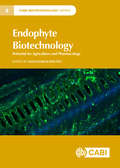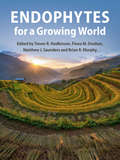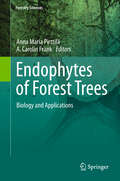- Table View
- List View
Endlich Biochemie verstehen
by Jonathan Wolf MuellerDieses Buch beantwortet brennende Fragen nach dem (molekularen) Sinn des Lebens und macht Lust auf mehr. Was ist es denn „was die Welt, im Innersten zusammenhält“. Das Buch ist als Lehrbuch konzipiert und macht übergeordnete Konzepte der Biochemie mit einfachen Bildern begreifbar. Die Konzepte oder spannenden Fragen der Kapitel werden mit viel Witz und über einfache Eselsbrücken den Studierenden näher gebracht.
Endocannabinoid Signaling
by Mauro MaccarroneThisvolume encompasses all major methodologies to interrogate endocannabinoidsystems (ECS) and endocannabinoids (eCBs) signaling. With increasing interesttowards the manifold activities of eCBs, this book discusses the chemical,biochemical, and molecular biological assays, and activity of distinct elementsof the ECS. These include membrane, nuclear receptors, biosynthetic andhydrolytic enzymes, and membrane transporters and oxidative enzymes. Written inthe highly successful Methods in Molecular Biology series format,chapters include introductions to their respective topics, lists of thenecessary materials and reagents, step-by-step, readily reproducible laboratoryprotocols, and tips on troubleshooting and avoiding known pitfalls. Timely and cutting edge, Endocannabinoid Signaling: Methods and Protocolsis a valuable resource and will help chemists, drug designers, biochemists,molecular biologists, cell biologists, pharmacologists, and (electro)physiologists navigate the mare magnum of endocannabinoid research.
Endocannabinoid Signaling: Methods and Protocols (Methods in Molecular Biology #2576)
by Mauro MaccarroneThis second edition provides new and updated chapters detailing all major elements of the ECB system. Chapters guide readers through identification of drug targets, electrophysiology, computational chemistry, and machine learning. Written in the successful Methods in Molecular Biology series format, chapters include introductions to their respective topics, lists of the necessary materials and reagents, step-by-step, readily reproducible protocols, and notes on troubleshooting and avoiding known pitfalls. Comprehensive and cutting-edge, Endocannabinoid Signaling: Methods and Protocols, Second Edition is a valuable resource for all researchers interested in learning more about this important and developing field.
Endocrine Disrupters in Wastewater and Sludge Treatment Processes
by Jason W. Birkett John N. LesterEndocrine Disrupting Chemicals (EDCs) have been shown to produce changes in the endocrine system of organisms, leading to increases in cancers and abnormalities in reproductive structure and function. This book presents research on the endocrine-disrupting effects of sewage and industrial effluents, covering the sources, fate, and transport of EDCs
Endocrine Disrupters: Hazard Testing and Assessment Methods
by Peter MatthiessenEnables researchers to assess the effects of endocrine disrupters as well as comply with new environmental regulations Endocrine disrupters are chemicals—both man-made and natural—that interfere with the body's endocrine system, potentially resulting in adverse developmental, reproductive, neurological, and immune effects. In recent years, a number of regulatory authorities around the world have drafted or enacted legislation that requires the detection and assessment of the effects of endocrine disrupters on both humans and wildlife. In response, this book provides comprehensive, up-to-date information on the latest tested and proven methods used to detect and assess the environmental hazards posed by endocrine-disrupting chemicals. Endocrine Disrupters is divided into chapters covering each major taxon as well as chapters dedicated to hazard assessment and regulation. The book covers testing methods for all the vertebrate groups and several invertebrate phyla, including: Crustaceans and mollusks Insects Fish Amphibians and reptiles Birds and mammals Moreover, the book emphasizes practical, ethical testing methods that combine sensitivity, efficiency, statistical power, and reasonable cost. Each chapter is written by one or more international experts in ecotoxicology, offering readers step-by-step guidance for implementing each method based on the latest research and the authors' firsthand laboratory experience. Furthermore, all the chapters have been subjected to a rigorous peer review and edited in light of the reviewers' comments. References at the end of each chapter guide readers to the literature in the field. Endocrine Disrupters is recommended for scientists who need to test chemicals for possible endocrine-disrupting properties. It is also recommended for regulatory authorities who need to decide whether particular chemicals can be safely marketed.
Endocrine Disrupting Chemicals-induced Metabolic Disorders and Treatment Strategies (Emerging Contaminants and Associated Treatment Technologies)
by Muhammad Zaffar Hashmi Muhammad Sajid Hamid Akash Kanwal RehmanThis volume offers a detailed and comprehensive analysis of Endocrine Disrupting Chemicals (EDCs), covering their occurrence, exposure to humans and the mechanisms that lead to the parthogenesis of EDCs-induced metabolic disorders. The book is divided into three parts. Part I describes the physiology of the human endocrine system, with special emphasis on various types of metabolic disorders along with risk factors that are responsible for the development of these disorders. Part II addresses all aspects of EDCs, including their role in the induction of various risk factors that are responsible for the development of metabolic disorders. Part III covers up-to-date environmental regulatory considerations and treatment strategies that have been adopted to cure and prevent EDCs-induced metabolic disorders. This section will primarily appeal to clinicians investigating the causes and treatment of metabolic disorders. The text will also be of interest to students and researchers in the fields of Environmental Pharmacology and Toxicology, Environmental Pollution, Pharmaceutical Biochemistry, Biotechnology, and Drug Metabolism/Pharmacokinetics.
Endocrine Disruption Modeling (QSAR in Environmental and Health Sciences)
by James DevillersUses Computational Tools to Simulate Endocrine Disruption PhenomenaEndocrine Disruption Modeling provides a practical overview of the current approaches for modeling endocrine activity and the related potential adverse effects they may induce on environmental and human health. Based on the extensive research of an international panel of contributor
Endocrine Disruptors and Puberty
by Evanthia Diamanti-Kandarakis Andrea C. GoreEndocrine disruption represents one of the most controversial environmental issues of our time. Mounting evidence stemming from more than 10 years of experimental, epidemiological and clinical studies has transformed the once generally discounted subject of endocrine disruptors into an issue of tremendous concern not only within the scientific community but among society as a whole. Following initial evidence from basic research, endocrine disruption in humans has now emerged as a major medical challenge. In this respect, puberty, a crucial developmental stage, has been definitively identified as a key window of vulnerability with regard to endocrine disruptors. Written by leading authorities in the field, Endocrine Disruptors and Puberty offers an engaging and comprehensive overview of this fascinating and rapidly growing problem. An indispensable resource for all clinicians and scientists interested in this challenging endocrinologic topic, Endocrine Disruptors and Puberty is a timely contribution that will help navigate a path toward understanding the problem and developing solutions.
Endocrine Pathology (Encyclopedia of Pathology)
by Stefano La Rosa Silvia UccellaThis encyclopedia volume covers the complete field of endocrine pathology – from Acidophil Stem Cell Adenoma to Waterhouse-Friderichsen syndrome. The alphabetically arranged entries, each of which provides a detailed description of a specific pathological disease pattern, allow readers to quickly and easily find the information they need.
Endocrine Toxicology (Target Organ Toxicology Series)
by John A. Thomas Howard D. ColbyThis text presents a range of topics from the molecular events surrounding hormone actions to epidemiologic studies of the effects of environmental and occupational chemicals on reproductive organs. The endocrine systems covered include the adrenal cortex, thyroid and parathyroid, gonads, and the endocrine pancreas. Of particular importance are the
Endocrine Toxicology (Target Organ Toxicology Series)
by J. Charles Eldridge James T. StevensWith contributions by international experts in academia, chemical manufacturing, government research laboratories, regulatory agencies, and private consulting, this guide explores the potentially damaging influence of environmental agents on the endocrine system. It examines endocrine toxicology's increased importance in environmental safety issues
Endocrine and Metabolic Disorders: Clinical Lab Testing Manual, Fourth Edition
by Robert F. Dons Frank H. Wians Jr.Bottom Line Information to Effectively Diagnose DisordersThe diagnosis, management, and clinical testing associated with old, traditional, and new endocrine disorders have seen numerous advances during the past 10 years since the publication of the previous edition of this bestselling resource. Updating its classic predecessor in content and format
Endocrinology of Social Relationships
by Peter B. Gray Peter T. EllisonIn social relationships―whether between mates, parents and offspring, or friends―we find much of life’s meaning. But in these relationships, so critical to our well-being, might we also detect the workings, even directives, of biology? This book, a rare melding of human and animal research and theoretical and empirical science, ventures into the most interesting realms of behavioral biology to examine the intimate role of endocrinology in social relationships. <P><P>The importance of hormones to reproductive behavior―from breeding cycles to male sexual display―is well known. What this book considers is the increasing evidence that hormones are just as important to social behavior. Peter Ellison and Peter Gray include the latest findings―both practical and theoretical―on the hormonal component of both casual interactions and fundamental bonds. The contributors, senior scholars and rising scientists whose work is shaping the field, go beyond the proximate mechanics of neuroendocrine physiology to integrate behavioral endocrinology with areas such as reproductive ecology and life history theory. Ranging broadly across taxa, from birds and rodents to primates, the volume pays particular attention to human endocrinology and social relationships, a focus largely missing from most works of behavioral endocrinology.
Endocytosis and Signaling (Progress in Molecular and Subcellular Biology #57)
by Christophe Lamaze Ian PriorThis book focuses on the context dependency of cell signaling by showing how the endosomal system helps to structure and regulate signaling pathways. The location and concentration of signaling nodes regulate their activation cycles and engagement with distinct effector pathways. Whilst many cell signaling pathways are initiated from the cell surface, endocytosis provides an opportunity for modulating signaling networks’ output. In this book, first a series of reviews describe the endocytic and endosomal system and show how these subcellular platforms sort and regulate a wide range of signaling pathway components and phenotypic outputs. The book then reviews the latest scientific insights into how endocytic trafficking and subcellular location modulate a set of major pathways that are essential to normal cellular function and organisms’ development.
Endocytosis in Plants
by Jozef ŠamajEndocytosis is a fundamental cellular process by means of which cells internalize extracellular and plasma membrane cargos for recycling or degradation. It is important for the establishment and maintenance of cell polarity, subcellular signaling and uptake of nutrients into specialized cells, but also for plant cell interactions with pathogenic and symbiotic microbes. Endocytosis starts by vesicle formation at the plasma membrane and progresses through early and late endosomal compartments. In these endosomes cargo is sorted and it is either recycled back to the plasma membrane, or degraded in the lytic vacuole. This book presents an overview of our current knowledge of endocytosis in plants with a main focus on the key molecules undergoing and regulating endocytosis. It also provides up to date methodological approaches as well as principles of protein, structural lipid, sugar and microbe internalization in plant cells. The individual chapters describe clathrin-mediated and fluid-phase endocytosis, as well as flotillin-mediated endocytosis and internalization of microbes. The book was written for a broad spectrum of readers including students, teachers and researchers.
Endogenous ADP-Ribosylation
by Friedrich Koch-NolteThis volume gathers the latest exciting findings on ADP-ribosylation from renowned experts in the field. It includes ten chapters, organized into the following three thematic sections: · Evolution and detection of endogenous ADP-ribosylation · ADP-ribosylation by the ARTC family of ADP-ribosyltransferases (R-S-E ARTs) · ADP-ribosylation by the ARTD family of ADP-ribosyltransferases (H-Y-E ARTs) The book will provide readers a better understanding of ADP-ribosylating toxins and their endogenous relatives. This provides a basis for developing novel toxin-neutralizing drugs and drugs targeting endogenous ADP-ribosyltransferase relatives.
Endogenous Opioids: From Basic Science to Biopsychosocial Applications (Advances in Neurobiology #35)
by Patrick L. Kerr Cristian Sirbu John M. GreggThis new volume provides a scientifically based exploration of the multifaceted world of endogenous opioids, including endorphins, enkephalins, dynorphins, endomorphins, and orphanin FQ/nociceptin, featuring a strong translational focus. Topics covered range from basic scientific investigations, to clinical applications, to investigations in areas such as oncology, childbirth, and disordered eating, to psychosocial contexts such as volunteering and positive emotions. One of the main goals of Endogenous Opioids is to provide recommendations for new directions in medical research and health policy that are rooted in sound scientific research.
Endogenous and Exogenous Regulation and Control of Physiological Systems (Biomedical Engineering Ser. #2)
by Robert B. NorthropFrom a biomedical engineering perspective, this book takes an analytic, quantitative approach to describing the basic components of physiological regulators and control systems (PRCs). In Endogenous and Exogenous Regulation and Control of Physiological Systems, the author provides grounding in the classical methods of designing linear and nonlinear systems. He also offers state-of-the-art material on the potential of PRCs to treat immune system ailments, most notably AIDS and cancer. The book focuses on certain "wet" physiological regulators, such as those using endocrine hormones as parametric control substances. Endogenous and Exogenous Regulation and Control of Physiological Systems includes simulations that illustrate model validations and the putative control of cancer and HIV proliferation. It explores novel, untried immunotherapies on the cutting-edge of PRC treatment and explores the latest technologies.
Endohedral Fullerenes: Electron Transfer and Spin (Nanostructure Science and Technology)
by Alexey A. PopovThis book discusses recent progress in endohedral fullerenes – their production and separation techniques, as well as their characterization and properties. Furthermore, the book delves into the all-important issue of stability by investigating electron transfer between the encapsulated metal species and the carbon cage. It also reviews spin-based phenomena caused by the shielding of endohedral spin by the fullerene, and analyzes formation of the spin states by charge transfer as studied by electron spin resonance. Tuning of charge states of endohedral species and of spin states of both the cage and the cluster are explained. Finally, the book considers the recent discovery of magnetism in some endohedral fullerenes, and the potential for quantum computing.
Endohedral Metallofullerenes: Basics and Applications
by Takeshi Akasaka Xing Lu Luis Echegoyen Alan L. Balch Shigeru NagaseKnowledge on endohedral metallofullerenes (EMFs) has increased dramatically during the last decade. Numerous research findings have been reported, making it an opportune time to provide a systematic update on EMFs. Endohedral Metallofullerenes: Basics and Applications presents the most comprehensive review on all aspects of EMFs including their gen
Endolichenic Fungi: Present and Future Trends
by Yogesh Joshi Manish TripathiThis book draws the reader into the latest debate on fungal diversity and the concept of lichen symbiosis. Chapters of this book cohere around four general themes: endolichenic fungi, isolation and culture, identification and bioactive potential. This is a highly informative book providing scientific insight for scholars interested in lichens and fungi. This research intrigues readers with this fascinating and less known fungal community residing inside lichens and arouses curiosity among lichenologists and mycologists about these fungi and their potential. This treatise provokes debate on the definition of lichen and its compositional organisms and invites further investigations on this topic by adding to the scholarly debate with various new perspectives on endolichenic fungi in the last chapter. Not only this, it also clarifies the differences between endolichenic fungi, mycorrhiza and lichenicolous fungi and the fungi found freely in air, water and soil and contributes to the development of the new field of endolichenic fungi. This book supports readers to build their knowledge through helpful case studies conducted throughout the globe and plentiful figures and illustrations and chemical structures of the novel compounds harvested from endolichenic fungi. This book covers both classical and cutting-edge technologies in the field of endolichenic fungi and offers step-by-step procedures for isolation and identification of endolichenic fungi and further contributes in how one can harvest the secondary metabolites from endolichenic fungi. This book shares the knowledge of some highly experienced authorities in the field of lichenology, mycology and endolichenic fungi and offers a first stop for specialists who need information about particular aspects in the field of endolichenic fungi. This research will equip researchers, professors, professionals working in this field to understand lichens and its intricate internal ecosystem with a fresh perspective and also enables readers to explore further through annotated references to other works.
Endolysosomal Voltage-Dependent Cation Channels (Handbook of Experimental Pharmacology #278)
by Christian Wahl-Schott Martin BielThis book covers the molecular structures and the cellular and in vivo function of endosomes and lysosomes, i.e. intracellular vesicles which are involved in many cellular processes such as endocytosis, intracellular trafficking, degradation of material from inside (e.g. autophagy) and outside the cell as well as exocytosis. Membranes of endolysosomal organelles contain an amazing number and diversity of ion channels. These ion channels are the topic of the present book that focusses on describing the structure, the biophysical properties, physiological functions of endolysosomal ion channels at the molecular, cellular and in vivo level.
Endophyte Biotechnology: Potential for Agriculture and Pharmacology (CABI Biotechnology Series)
by Jutta Ludwig-Müller Stéphane Compant Alan C. Gange Peter Fredman Alec Baird Gabriele Berg Alessandro Bergna John R. Caradus Tomislav Cernava Sang Cho Amanda F. Currie Sherif S. Ebada Weaam Ebrahim Pablo A. García-Parisi Zachery Gray Evan Groover Roman Harto Marian Hsieh Linda J. Johnson Katie Malmberg Ryan Manglona Malia Mercer Christina A. Müller Natalie Nasman Tatiana Nicklason Melanie M. Obermeier Marina Omacini Peter Proksch Melissa Rienstra Rusty Rodriguez Jessica-Rose Spong Corinne Vacher Alex Van Inwegen Andy VanHooser Christin ZachowEndophytes are bacterial and fungal microorganisms that colonize plants without usually eliciting visible disease symptoms but establishing intricate and mutually beneficial interactions with their host plant. This can lead to an increase in plant vigour, growth, development, and changes in plant metabolism. Endophytes may assist in the development of more productive and sustainable agricultural practices or discoveries of novel pharmacologicals. These elusive organisms are often overlooked and their benefits underrated. Endophytes can support plants in a variety of ways to cope with biotic and abiotic stress factors, such as drought, heat, pest and diseases. They can produce particular metabolites, facilitate access to nutrients, change the plant's chemistry, physiology and responses, or by a combination of these factors. The biosynthetic pathways present in endophytes alone or in combinations with the plant's, can lead to novel chemicals, with yet undiscovered pharmacological characteristics. With state-of-the-art knowledge on their discovery and roles, this book describes the diversity of endophytes, their value, exploitation and future challenges. Key features: Provides an overview of the endophytes that are encountered in nature. Demonstrates the beneficial effects of endophytes together with their practical applications in agriculture. Explores how endophytes are valuable candidates for research on future drugs and biopesticides. This title is a valuable resource for students and researchers in plant science and plant pathology as well as those working in the pharmaceutical and pesticide industries.
Endophytes for a Growing World
by Trevor R. Hodkinson Fiona M. Doohan Matthew J. Saunders Brian R. MurphyThe book brings together papers covering the most recent scientific research from the top endophyte researchers in the world. It presents the state of the art in our knowledge and technical capacity and explores future directions of this work. It is highly relevant and timely because of the need to improve global food security and its sustainability, and also to provide novel bioactive molecules for medicine. There is also a need to protect forestry in a changing and growing world. Endophytes offer a huge potential to reduce environmentally damaging agricultural inputs such as fertilisers and pesticides. They are also a largely overlooked group of organisms where much basic science remains to be undertaken. For example, new molecular tools of DNA profiling using high throughput environmental sequencing are allowing the exploration of a previously largely unknown resource. There is a pressing need to convert scientific research on endophytes into practical application. This book describes how that will be achieved.
Endophytes of Forest Trees
by Anna Maria Pirttilä A. Carolin FrankFound in every plant species, the diversity of endophytic micro-organisms can be extremely high within different plant organs and tissue types. In trees, their ecological roles with respect to host tree can vary from latent pathogens or saprophytes to neutral commensalists and mutualists. Given their high diversity, and their bio-active nature, endophytes are currently being associated with a role in tree health against insect herbivores and fungal pathogens, as well as improving tree properties in phytoremediation. Meanwhile there is increasing interest in the potential of some tree endophytes as new sources of drug compounds. The first book on tree endophytes in several years, and containing contributions from leading authors in the field, this book provides an important reference text for professional researchers and advanced students.

